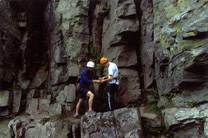themes
themes
Page 3
1 | 2 | 3 | 4 | 5
Sport, Recreation and Leisure
Pictures and Film
Entertainment in 1887 included a magic lantern show for the boys and, in October 1889, the magic lantern was still in use, showing ‘a display of views of Paris exhibition’.
(Visitors’ Book 1859-1963, 17th October 1887 and 9th October 1889)
The magic lantern was still going strong in 1904, when the children were entertained with ‘views illustrative of the ascent of Mont Blanc and views in Switzerland’.
(Visitors’ Book 1859-1963, Mr. James Clark, 29th October 1904)
More modern variations of this type of entertainment have continued: during the winter, weekly films were shown in the school throughout the 1940s and 1950s, when visits to the cinema during weekend leave were also popular; videos and, more recently, DVDs still provide evening entertainment.
This is perhaps surprising, given the perception of cinema houses’ association with juvenile crime during the early 20th century, recorded in both Kibble’s own records and wider literature. Author Geoffrey Pearson discusses a 1917 report by the National Council of Public Morals:
…the National Council of Public Morals addressed itself with particular vigour to the belief ‘that the picture house is responsible for the increase in juvenile crime, and that boys are often led to imitate crimes (larceny or burglary) which they have seen in the pictures, or to steal money that they may pay for admission’.2
Nonetheless, as Pearson points out, the report discounted the fear of imitative crime, concluding that ‘it certainly has not been proved that the increase in juvenile crime generally has been consequent on the cinema’3
“Picture houses” and “picture shows” are cited repeatedly in Kibble’s records as a cause of delinquency for boys admitted during 1911 and 1912. The strength of feeling about this perceived phenomenon is illustrated in the language used at the time:
‘…fond of attending picture shows and would get money any possible way to satisfy his craving for this’ ‘In majority of cases…found that the Moving Picture Shows have exercised an influence over the boys, who have used every means in their power – honest or otherwise – in order to satisfy their desire to attend these entertainments’.
(Minutes of Education Committee Meetings1910-1914, 22nd December 1911 Minutes)
This lends a certain irony to the fact that two members of Kibble staff, a joiner and another staff member, left to open a ‘cinema house’ in Castle Street in 1915!
(Minutes of Industrial Committee Meetings 1905-1928, 2nd July 1915 Minutes)
The focus on potential causes of juvenile crime during the first half of the twentieth century reflected increases in juvenile delinquency rates in this period; the figures began to increase steeply in 1910, reaching record proportions in 1914-18. The number then fell after the First World War, before a sharp increase in the 1930s, and reached new record high levels at the outbreak of World War II in 1939.4 These facts may, therefore, indicate that statistical increases were more related to economic deprivation and the hardships of wartime, rather than to forms of popular entertainment.
The seriousness of contemporary concerns about the potentially negative effects of some leisure activities were again highlighted in 1917, when James Cooper of Glasgow University gave an address at Kibble to a joint meeting of Teachers’ Associations of Renfrewshire on ‘Training to use Leisure’.
(Visitors’ Book 1859-1963, 24th March 1917)
Other entertainments included a concert given by members of Paisley Opera Club in May 1906 and, later that year, ‘excellent entertainment given to the boys ‘in honour of Halloween’.
(Visitors’ Book 1859-1963, 12th May 1906 and 2nd November 1906)
2Pearson, Geoffrey, Hooligan, A history of respectable fears, London, MacMillan Education Ltd, 1983, p.32
3Pearson, Geoffrey, Hooligan, A history of respectable fears, London, MacMillan Education Ltd, 1983, p.32
4Ferguson, T., The Young Delinquent in his Social Setting, London, Oxford University Press, 1952, p.11

